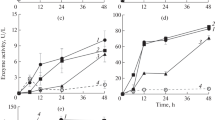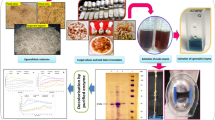Abstract
The phenolics and high organic content present in palm oil mill effluent are the major contributors to its dark brown color, toxicity, and antimicrobial properties. In this study, ten white rot fungi were screened for their potential in the dephenolization and decolorization of treated palm oil mill effluent (TPOME) in solid and liquid state cultures. Among them, Trametes hirsuta strain AK 04 was found to be more tolerant to high TPOME concentrations and showed the highest phenolics and color removal activities. This strain was immobilized onto oil palm fibers (OPFs) and appeared more resistant to inhibitory compounds such as phenolics in TPOME than the free cell culture. The OPF-immobilized fungus was able to effectively remove phenolics and color of TPOME without effluent dilution and addition of nutrients. The activities of laccase and manganese peroxidase were found during dephenolization and decolorization processes. Moreover, the degradation rate of immobilized fungus could be accelerated by pretreatment of phenolics with phenol-degrading bacteria. This method improved the fungal dephenolization and decolorization simultaneously up to 82.2 ± 3.8 % and 87.1 ± 1.1 % after 8 days of incubation. Therefore, a two-stage biological process containing phenol-degrading bacteria and OPF-immobilized fungus could be a feasible and economical method for simultaneous improvement of dephenolization and decolorization of TPOME.


Similar content being viewed by others
References
Ahmad, A. L., Ismail, S., & Bhatia, S. (2003). Water recycling from palm oil mill effluent (POME) using membrane technology. Desalination, 157, 87–95.
Ahmadi, M., Vahabzadeh, F., Bonakdarpour, B., Mehranian, M., & Mofarrah, E. (2006). Phenolic removal in olive mill wastewater using loofah-immobilized Phanerochaete chrysosporium. World Journal of Microbiology and Biotechnology, 22, 119–127.
Alam, M. Z., Ameem, E. S., Muyibi, S. A., & Kabbashi, N. A. (2009). The factors affecting the performance of activated carbon prepared from oil palm empty fruit bunches for adsorption of phenol. Chemical Engineering Journal, 155, 191–198.
Amir, S., Hafidi, M., Lemee, L., Merlina, G., Guiresse, M., Pinelli, E., Revel, J. C., Bailly, J. R., & Ambles, A. (2006). Structural characterization of humic acid, extracted from sewage sludge during composting, by thermochemolysis-gaschromatography-mass spectrometry. Process Biochemistry, 41, 410–422.
APHA, AWWA, & WEF. (2005). Standard methods for the examination of water and wastewater (21st ed.). Washington DC: American Public Health Association.
Assas, N., Ayed, L., Bouallagui, H., Sayadi, S., & Hamdi, M. (2009). Biodegradation of different molecular-mass polyphenols derived from olive mill wastewaters by Geotrichum candidum. International Biodeterioration & Biodegradation, 63, 407–413.
Chantho, P., Musikavong, C., Suttinun, O. (2013). Pretreatment of phenolic compounds in palm oil mill wastewater by the thermophilic Bacillus thermoleovorans strain A2 for enhancement of biogas production. In proceedings of the 2nd International Conference on Environmental Science & Engineering and Management; March 27-29, 2013; Khon Kaen, Thailand.
Chavalparit, O., Rulken, S. W. H., Mol, A. P. J., & Khaodhair, S. (2006). Options for environmental sustainability of the crude palm oil industry in Thailand through enhancement of industrial ecosystems. Environment, Development and Sustainability, 8, 271–287.
Chefetz, B., Chen, Y., Clapp, C. E., & Hatcher, P. G. (2000). Characterization of organic matter in soils by thermochemolysis using tetramethylammonium hydroxide (TMAH). Soil Science Society of America Journal, 64, 583–589.
D’Annibale, A., Casa, R., Pieruccetti, F., Ricci, M., & Marabottini, R. (2004). Lentinula edodes removes phenols from olive mill wastewater: impact on durum wheat (Triticum durum Desf.) germinability. Chemosphere, 54, 887–894.
Ergül, F. E., Sagin, S., Öngen, G., & Sukan, F. V. (2009). Dephenolisation of olive mill wastewater using adapted Trametes versicolor. International Biodeterioration and Biodegradation, 63, 1–6.
Ergül, F. E., Sagin, S., Öngen, G., & Sukan, F. V. (2011). Dephenolization and decolorization of olive mill wastewater through sequential batch and co-culture application. World Journal of Microbiology and Biotechnology, 27, 107–114.
Fountoulakis, M. S., Dokianakis, S. N., & Kornaros, M. E. (2002). Removal of phenolics in olive mill wastewaters using the white-rot fungus Pleurotus ostreatus. Water Research, 36, 4735–4744.
Gao, D., Du, L., Yang, J., Wu, W. N., & Liang, H. (2010). A critical review of the application of white rot fungus to environmental pollution control. Critical Reviews in Biotechnology, 30(1), 70–77.
Heinfling, A., Martinez, M. J., Martinez, A. T., Bergbaure, M., & Szewzyk, U. (1998). Transformation of industrial dyes by manganese peroxidase from Bjerkandera adusta and Pleurotus eryngii in a manganese-independent reaction. Applied and Environmental Microbiology, 64(8), 2788–2793.
Hernandez, J. E., & Edyvean, R. G. (2008). Inhibition of biogas production and biodegradability by substituted phenolic compounds in anaerobic sludge. Journal of Hazardous Materials, 160, 20–28.
Kadimaliev, D. A., Revin, V. V., Atykyan, N. A., Nadezhina, O. S., & Parshin, A. A. (2011). The role of laccase and peroxidase of Lentinus (Panus) tigrinus fungus in biodegradation of high phenol concentrations in liquid medium. Applied Biochemistry and Microbiology, 47, 66–71.
Kaewmai, R., H-Kittikun, A., Suksaroj, C., & Musikavong, C. (2013). Alternative technologies for the reduction of greenhouse gas emissions from palm oil mills in Thailand. Environmental Science and Technology, 47, 12417–12425.
Khongkhaem, P., Intasiri, A., & Luepromchai, E. (2011). Silica-immobilized Methylobacterium sp. NP3 and Acinetobacter sp. PK1 degrade high concentrations of phenol. Letters in Applied Microbiology, 52, 448–455.
Lakhtar, H., Ismaili-Alaoui, M., Philippoussis, A., Perraud-Gaime, I., & Roussos, S. (2010). Screening of strains of Lentinula edodes grown on model olive mill wastewater in solid and liquid state culture for polyphenol biodegradation. International Biodeterioration and Biodegradation, 64, 167–172.
Levin, L., Papinutti, L., & Forchiassin, F. (2004). Evaluation of Argentinean white rot fungi for their ability to produce lignin-modifying enzyme and decolorize industrial dyes. Bioresource Technology, 94, 169–176.
Limkhuansuwan, V., & Chaiprasert, P. (2010). Decolorization of molasses melanoidins and palm oil mill effluent phenolic compounds by fermentative lactic acid bacteria. Journal of Environmental Sciences, 22, 1209–1217.
Lu, Y., Yan, L., Wang, Y., Zhou, S., Fu, J., & Zhang, J. (2009). Biodegradation of phenolic compounds from coking wastewater by immobilized white rot fungus Phanerochaete chrysosporium. Journal of Hazardous Materials, 165, 1091–1097.
Neoh, C. H., Lam, C. Y., Lim, C. K., Yahya, A., & Ibrahim, Z. (2014). Decolorization of palm oil mill effluent using growing cultures of Curvularia clavata. Environmental Science and Pollution Research, 21, 4397–4408.
Öngen, G., Güngör, G., & Kanberoglu, B. (2007). Decolorisation and dephenolisation potential of selected Aspergillus section Nigri strains-Aspergillus tubingensis in olive mill wastewater. World Journal of Microbiology and Biotechnology, 23, 519–524.
Oswal, N., Sarma, P. M., Zinjarde, S. S., & Pant, A. (2002). Palm oil mill effluent treatment by a tropical marine yeast. Bioresource Technology, 85, 35–37.
Owen, R., Mier, W., Giacosa, A., Hull, W., Spiegelhalder, B., & Bartsch, H. (2000). Phenolic compounds and squalene in olive oils: the concentration and antioxidant potential of total phenols, simple phenols, secoiridoids, lignans and squalene. Food and Chemical Toxicology, 38, 647–659.
Quinn, B. P., Berniern, U. R., Gedenm, C. J., Hogsette, J. A., & Carlson, D. A. (2007). Analysis of extracts and volatile components in blackstrap molasses feed as candidate house fly attractants. Journal of Chromatography. A, 1139, 279–284.
Ramos-Cormenzana, A., Juarez-Jimenez, B., & Garcia-Pareja, M. P. (1996). Antimicrobial activity of olive mill wastewaters (alpechin) and biotransformed olive oil mill wastewater. International Biodeterioration & Biodegradation, 38, 283–290.
Rodrígues, E., Pickard, M. A., & Vazquez-Duhalt, R. (1999). Industrial dye decolorization by laccase from ligninolytic fungi. Current Microbiology, 38, 27–32.
Rodríguez-Couto, S. R., Domínguez, A., & Sanromán, A. (2001). Utilization of lignocellulosic wastes for lignin peroxidase production by semi-solid-state cultures of Phanerochaete chrysosporium. Biodegradation, 12, 283–289.
Sayadi, S., Allouche, N., Jaoua, M., & Aloui, F. (2000). Detrimental effects of high molecular-mass polyphenols on olive mill wastewater biotreatment. Process Biochemistry, 35, 725–735.
Shin, M., Nguyen, T., & Ramsay, J. (2002). Evaluation of support materials for the surface immobilization and decolorization of amaranth by Trametes versicolor. Applied Microbiology and Biotechnology, 60, 218–223.
Tinoco, P., Almendros, G., Sanz, J., González-Vázquez, R., & González-Vla, F. J. (2006). Molecular descriptors of the effect of fire on soils under pine forest in two continental Mediterranean soils. Organic Geochemistry, 37, 1995–2018.
Yadav, S., & Chandra, R. (2012). Biodegradation of organic compounds of molasses melanoidin (MM) from biomethanated distillery spent wash (BMDS) during the decolorisation by a potential bacterial consortium. Biodegradation, 23, 609–620.
Acknowledgements
This work was supported by the Thailand Research Fund through the new scholar grant (contract no. MRG5480087) and the Graduate School, Prince of Songkla University. We are grateful to Asst. Prof. Dr. Ekawan Luepromchai (Chulalongkorn University, Thailand) who has kindly provided us with the bacterial strains for this research. We would also like to thank the Faculty of Environmental Management, Prince of Songkla University and the Center of Excellence on Hazardous Substance Management (HSM) at Prince of Songkla University for providing laboratory space and instruments.
Compliance with Ethical Standards
The authors declare that they have no competing of interest.
Author information
Authors and Affiliations
Corresponding author
Rights and permissions
About this article
Cite this article
Kietkwanboot, A., Tran, H.T.M. & Suttinun, O. Simultaneous Dephenolization and Decolorization of Treated Palm Oil Mill Effluent by Oil Palm Fiber-Immobilized Trametes Hirsuta Strain AK 04. Water Air Soil Pollut 226, 345 (2015). https://doi.org/10.1007/s11270-015-2599-8
Received:
Accepted:
Published:
DOI: https://doi.org/10.1007/s11270-015-2599-8




